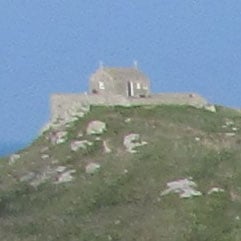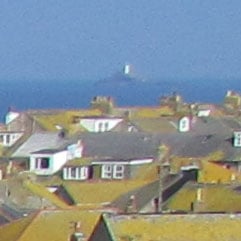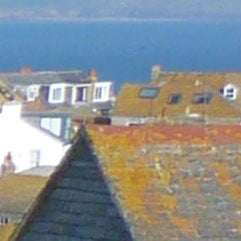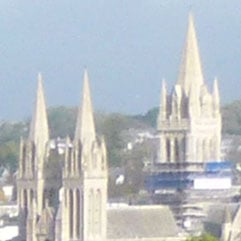Panasonic Lumix DMC-FZ100
-
-
Written by Gordon Laing
Quality
Panasonic Lumix FZ100 vs Lumix FZ45 / FZ40 vs Canon PowerShot SX30 IS Real-life resolution (wide)
Panasonic Lumix FZ100 results : Real-life resolution / Sharpness mid-range / Sharpness tele / High ISO Noise / Vs FZ38 / FZ35
Panasonic Lumix FZ100 results : Real-life resolution / Sharpness mid-range / Sharpness tele / High ISO Noise / Vs FZ38 / FZ35
All three cameras were set to Program mode at the lowest available ISO sensitivity – 100 ISO on the Lumix FZ100 and 80 ISO on the Lumix FZ45 / FZ40 and PowerShot SX30 IS. The above image was taken with the Lumix FZ100 in Program mode. The lens was set to 4.5mm (25mm equivalent) and the metering selected an exposure of 1/800 at f4 at an ISO setting of 100. The original 4320 × 3240 pixel image had a file size of 5.67MB. We’ve talked before about the difficulties this scene presents, in the mid-day autumn sunsine there’s a wide range of tones to capture, from the foreground shadow to the whitewashed walls. On the whole the Lumix FZ100 has done an ok job with the exposure, though it has overexposed the scene slightly. The auto white balance has made a good job of assessing the scene – there’s no perceptible colour cast and the colours are well balanced, vivid and natural-looking. The detailed crops are something of a disappointment though. Without exception, they all look quite soft and fine detail is all but obscured. Look at the windows of the foreground houses in the second crop, the roof tiles in the third crop and the windows and balcony dividers in the fourth crop – all of the detail is soft and indistinct compared with the crops from the Lumix FZ45 / FZ40 and the PowerShot SX30 IS. The comparison with the FZ45 / FZ40 is of course interesting as both cameras share the same lens, which suggests that it’s the Lumix FZ100’s sensor and image processing that is the issue. One possibility is that the FZ100’s sensor has a worse noise performance than that of the FZ45 / FZ40 and Panasonic has increased the noise reduction to compensate. If this is the case it might be possible to squeeze a better quality JPEG from the FZ100 by adjusting the noise reduction and sharpness settings for JPEGs, or shooting RAW and processing the files using the supplied Silkypix RAW converter software or a third party conversion utility. Scroll down below the main crops to see a comparison of JPEGs at different processing settings, followed by some RAW comparisons. Wide angle performance is only part of the story though, for the full picture make sure to take a look at our mid-range resolution and telephoto resolution test pages before seeing how they compare at higher sensitivities in our High ISO Noise results – and don’t forget our RAW results at the bottom of this page. We also have a comparison against its predecessor in our Lumix FZ45 / FZ40 versus FZ38 / FZ35 page.
Panasonic Lumix FZ100: trying to get the best out of the sensorAs mentioned above, we believe the FZ100’s sensor suffers from worse noise than the FZ45 / FZ40 and Panasonic has increased the noise reduction to compensate. If this is the case it might be possible to squeeze a better quality JPEG from the FZ100 by adjusting the noise reduction and sharpness settings for JPEGs, or shooting RAW and processing the files using the supplied Silkypix RAW converter software or a third party conversion utility. To put this theory to the test, we shot the same scene using the Panasonic FZ100 using its best quality JPEG setting with different noise reduction and sharpness settings. The FZ100 was set to Program mode and at 100 ISO selected an exposure of 1/500 at f4. There’s a clear improvement in image detail in the second crop taken with NR set to -1 with little if any perceptible increase in noise, while the third crop with NR reduced to -1 and Sharpness increased to +1 shows more detail still. At the lowest ISO setting at least, it’s worth considering adjusting the default noise reduction and sharpness in this way. But at higher sensitivities, noise will become more obtrusive with these settings. Scroll down to see if there’s any benefit to shooting in RAW with the FZ100, or if you’re ready to move on, check out the camera’s performance at different focal lengths in our mid-range resolution and telephoto resolution test pages before seeing how it compares at higher sensitivities in our High ISO Noise results.
|
|
We photographed the scene pictured above using the FZ100’s RAW plus Large Fine JPEG mode, allowing us to directly compare images created from exactly the same data. Below are 100% crops taken from the original JPEG file alongside the RAW version, processed with the supplied Silkypix Developer Studio 3.1 SE; by default, the Unsharp Mask is set to zero in SilkyPIX, which unsurprisingly delivers a very soft result, so here we’ve increased the amount to 100 in order to accentuate fine details. We’ve also included crops taken from the FZ45 / FZ40’s RAW file, processed with the same settings for comparison. Note in the first row of crops, the distant building was in shade when we took our FZ45 / FZ40 sample, but the other areas of the composition weren’t affected. At first glance the in-camera JPEG and processed RAW results from the FZ45 / FZ40 look quite similar with the default settings, but look closely and you’ll spot greater noise speckles on the latter, especially in flat areas of colour like the blue sky. Clearly the FZ45 / FZ40 is applying greater noise reduction to its in-camera JPEGs by default than the standard settings of Silkypix. Which is better is entirely personal: some may like all speckles to be smoothed-out by noise reduction, even at the cost of ultimate detail, while others will prefer a more hands-off approach which leaves some noise behind in an attempt to preserve detail. Of course the important question is whether there is actually any more detail visible on the RAW version, and the answer is very little in this case. But the valuable thing is having access to a wide variety of settings to tweak, along a higher dynamic range to play with, so those who want to get the best from their FZ45 / FZ40 should definitely shoot in RAW and experiment with different settings for the desired result. Moving onto the FZ100 crops, it’s clear they’re also showing more noise speckles than the in-camera JPEG; it’s certainly revealing to see the FZ100 RAW file suffering from more noise than the FZ45 / FZ40 at the same ISO sensitivity. But while the FZ100 RAW crops below are noisier than those from the FZ45 / FZ40 alongside it, they’re arguably preferable to the overly-smeared results from in-camera JPEGs. Clearly the FZ100’s MOS sensor is noisier than the CCD in the FZ45 / FZ40, and Panasonic has attempted to mask this with overly-aggressive noise reduction. But for our money, turning down the noise reduction, whether on in-camera JPEGs or by processing RAW files, produces a better result. Yes there’s much more visible noise, but also lots more detail. Now let’s look at how the camera performs at longer focal lengths in our mid-range resolution and telephoto resolution test pages before seeing how it compares at higher sensitivities in our High ISO Noise results. |
Panasonic Lumix FZ100 |
Panasonic Lumix FZ100 (RAW) |
Panasonic Lumix FZ45 / FZ40 (RAW) | ||
 |  |  | ||
f4, 100 ISO |
f4, 100 ISO |
f4, 80 ISO | ||
 |  |  | ||
f4, 100 ISO |
f4, 100 ISO |
f4, 80 ISO | ||
 |  |  | ||
f4, 100 ISO |
f4, 100 ISO |
f4, 80 ISO | ||
 |  | 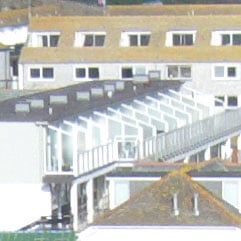 | ||
f4, 100 ISO |
f4, 100 ISO |
f4, 80 ISO |
Panasonic Lumix FZ100 vs Lumix FZ45 / FZ40 vs Canon PowerShot SX30 IS Real-life resolution (approx 300mm)
Panasonic Lumix FZ100 results : Real-life resolution / Sharpness mid-range / Sharpness tele / High ISO Noise / Vs FZ38 / FZ35
Panasonic Lumix FZ100 |
Panasonic Lumix FZ45 / FZ40 |
Canon PowerShot SX30 IS | ||
 |  |  | ||
47.5mm (264mm) f4.5, 100 ISO |
48.8mm (271mm) f4, 80 ISO |
56.1mm (313mm) f5, 80 ISO | ||
 |  |  | ||
47.5mm (264mm) f4.5, 100 ISO |
48.8mm (271mm) f4, 80 ISO |
56.1mm (313mm) f5, 80 ISO | ||
 |  |  | ||
47.5mm (264mm) f4.5, 100 ISO |
48.8mm (271mm) f4, 80 ISO |
56.1mm (313mm) f5, 80 ISO | ||
 |  |  | ||
47.5mm (264mm) f4.5, 100 ISO |
48.8mm (271mm) f4, 80 ISO |
56.1mm (313mm) f5, 80 ISO |
Panasonic Lumix FZ100 results : Real-life resolution / Sharpness mid-range / Sharpness tele / High ISO Noise / Vs FZ38 / FZ35

To compare real-life performance mid-way through their focal ranges, we shot this scene with the Panasonic Lumix FZ100, Lumix FZ45 / FZ40 and the Canon PowerShot SX30 IS within a few moments of each other using their best quality JPEG settings. The lenses on each camera were set to approximately the same field of view to evaluate their performance around the middle of their zoom range. We opted for an equivalent focal length of around 300mm on each model. All three cameras were set to Program mode at the lowest available ISO sensitivity – 100 ISO on the Lumix FZ100 and 80 ISO on the Lumix FZ45 / FZ40 and PowerShot SX30 IS. The above image was taken with the Lumix FZ100 in Program mode. The lens was set to 47.5 mm (264mm equivalent) and the metering selected an exposure of 1/2000 at f4.5 with an ISO setting of 100. The original 4320 × 3240 pixel image had a file size of about 5MB. As with the wide angle crops the Limix FZ100 looks very soft and lacking in detail compared with both the Lumix FZ45 / FZ40 and the PowerShot SX30 IS. In the first crop, you might argue that the image is merely less contrasty, but there’s no escaping the lost of detail and even smearing that’s visible in the second crop of the brickwork. And in the bottom crop none of the detail in the roof tiles that’s showing in the FZ45 / FZ40 and SX30 IS crops is visible in the FZ100 crop. The third crop is interesting because it shows something you can’t see so much in the others. It looks very much like noise, or evidence of its suppression, or both. There’s a clumpy look to the detail which, interestingly, is more apparent in the punchier, sharper FZ45 / FZ40 crop. As far as middle of the zoom range performance goes, this is an easy call to make, with the PowerShot SX30 IS in first place, the Lumix FZ45 / FZ40 a creditable second and the FZ100 trailing in third place. If you haven’t done so already, be sure to take a look at our wide-angle resolution and telephoto resolution test pages before seeing how they compare at higher sensitivities in our High ISO Noise results. |
Panasonic Lumix FZ100 vs Lumix FZ45 / FZ40 vs Canon PowerShot SX30 IS Real-life resolution (telephoto)
Panasonic Lumix FZ100 results : Real-life resolution / Sharpness mid-range / Sharpness tele / High ISO Noise / Vs FZ38 / FZ35
Panasonic Lumix FZ100 |
Panasonic Lumix FZ45 / FZ40 |
Canon PowerShot SX30 IS | ||
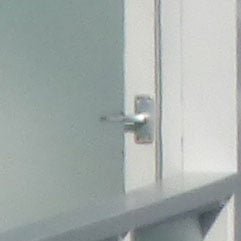 |  |  | ||
108mm (600mm) f5.2, 100 ISO |
108mm (600mm) f5.2, 80 ISO |
150.5mm (840mm) f5.8, 80 ISO | ||
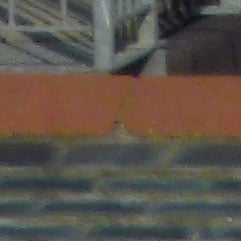 |  |  | ||
108mm (600mm) f5.2, 100 ISO |
108mm (600mm) f5.2, 80 ISO |
150.5mm (840mm) f5.8, 80 ISO | ||
 |  |  | ||
108mm (600mm) f5.2, 100 ISO |
108mm (600mm) f5.2, 80 ISO |
150.5mm (840mm) f5.8, 80 ISO |
Panasonic Lumix FZ100 results : Real-life resolution / Sharpness mid-range / Sharpness tele / High ISO Noise / Vs FZ38 / FZ35

To compare real-life performance with the lenses zoomed all the way in, we shot this scene with the Panasonic Lumix FZ100, the Lumix FZ45 / FZ40 and the Canon PowerShot SX30 IS within a few moments of each other using their best quality JPEG settings. The lenses on each camera were set to the maximum telephoto end of their zoom range. For the Lumix FZ100 and Lumix FZ45 / FZ40 this is an equivalent of 600m and for the Canon Powershot SX30 IS it’s 840mm. All three cameras were set to Program mode at the lowest available ISO sensitivity – 100 ISO on the Lumix FZ100 and 80 ISO on the Lumix FZ45 / FZ40 and the PowerShot SX30 IS. The above image was taken with the Lumix FZ100 in Program mode. The lens was set to 108 mm (600mm equivalent) and the metering selected an exposure of 1/1600 at f5.2 with an ISO setting of 100. The original 4320 × 3240 pixel image had a file size of 4.91MB. At the maximum telephoto end of its reach, 600mm equivalent, the Panasonic Lumix FZ100 results bear out what we’ve seen at the wide angle and mid-point of the telephoto range. Once again the crops are soft on details and show a clumpiness that’s suggestive of a much higher ISO sensitivity than the 80 ISO at which they were shot. Having said that, looking at the extremely granular crops from the Lumix FZ45 / FZ40, you might prefer the softness of the FZ100 crops. In this set of crops, the Canon PowerShot SX30 IS treads the middle path producing a more balanced result. At this stage its worth noting that the Lumix FZ100 image quality, while not the best we’ve seen and not up to the standards of either the Lumix FZ45 / FZ40 or the PowerShot SX30 IS, is by no means poor. The FZ100 doesn’t suffer from the SX30’s colour fringing problem and its overall image quality is certainly good enough for most applications. And, as we’ve seen, with a little effort there are some steps you can take to improve it. If you haven’t done so already, be sure to take a look at our wide-angle resolution and mid range resolution test pages before seeing how they compare at higher sensitivities in our High ISO Noise results. |
Panasonic Lumix FZ38 / FZ35 vs Lumix FZ45 / FZ40 vs Lumix FZ100 Real-life resolution RAW (wide)
Panasonic Lumix FZ100 results : Real-life resolution / Sharpness mid-range / Sharpness tele / High ISO Noise / Vs FZ38 / FZ35
Panasonic Lumix FZ38 / FZ35 (RAW) |
Panasonic Lumix FZ45 / FZ40 |
Panasonic Lumix FZ100 | ||
 |  |  | ||
f4, 80 ISO |
f4, 80 ISO |
f4, 100 ISO | ||
 |  |  | ||
f4, 80 ISO |
f4, 80 ISO |
f4, 100 ISO | ||
 |  |  | ||
f4, 80 ISO |
f4, 80 ISO |
f4, 100 ISO | ||
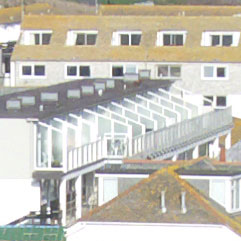 |  |  | ||
f4, 80 ISO |
f4, 80 ISO |
f4, 100 ISO |
Panasonic Lumix FZ100 results : Real-life resolution / Sharpness mid-range / Sharpness tele / High ISO Noise / Vs FZ38 / FZ35
We shot the scene opposite with the Panasonic Lumix FZ38 / FZ35, Lumix FZ45 / FZ40 and the Lumix FZ100 in RAW+JPEG mode so that we could compare images produced from each camera using the RAW data. The lenses on each camera were set to approximately the same field of view. As all three cameras have closely matched maximum wide-angle focal lengths – 27mm equiv for the Lumix FZ38 / FZ35 and 25mm equiv for the Lumix FZ45 / FZ40 and FZ100 we used these settings for our wide-angle quality comparisons. All three cameras were set to their lowest available ISO sensitivity – 80 ISO on the Lumix FZ38 / FZ35 and FZ45 / FZ40, and 100 ISO on the Lumix FZ100. The RAW image files were processed using the supplied SilkyPIX Developer Studio 3.1 SE. By default, the Unsharp Mask is set to zero in SilkyPIX, which unsurprisingly delivers a very soft result, so here we’ve increased the amount to 100 in order to accentuate fine details. For a level playing field, not to mention to avoid diffraction, we set the aperture to f4 on all three models using Aperture Priority; note the earlier FZ38 / FZ35 has a tendency to select f5.6 in program or Auto modes, given a bright scene, and as we saw in our review of that model, this will soften the result due to diffraction. The image above was taken with the Lumix FZ38 / FZ35 with the lens at 4.8mm (27mm equivalent), where the metering selected an exposure of 1/500 at f4 using an ISO setting of 80. The original RAW file was 14MB from which SilkyPIX produced a 5MB JPEG. We’ve seen test crops from the Lumix FZ38 / FZ35 before, of course, in our full review, but what’s interesting here is to compare it with images shot from the the two newer cameras, the FZ45 / FZ40 and the FZ100, particularly in light of reports that the Image quality of the FZ45 / FZ40 and FZ100 are not up to that of their predecessor. We’ve looked long and hard at the 100 percent crops below and it really is too close to call for the FZ38 / FZ35 versus the FZ45 / FZ40, at least at 80 ISO. Doubtless there will, and have been, those who say the image quality of the FZ38 / FZ35 is better than that of the FZ45 / FZ40, but we’d put them neck and neck here at their lowest sensitivity. Look closely and the FZ45 / FZ40 looks to be marginally better in terms of detail on the lighthouse crop and the third crop from the frame edge with the roof tiles. But in the first and last crops the FZ38 / FZ35 looks slightly sharper and more detailed. The earlier model also has fractionally fewer noise speckles in areas of flat colour like the blue sky, but again this is serious pixel-peeping. Don’t forget that with these comparisons we’re also not comparing shots from the same sized sensor shot at exactly the same focal length. The FZ38 / FZ35’s 12 Megapixel sensor produces a 4000 x 3000 pixel image whereas images from the 14 Megapixel FZ45 / FZ40 measure 4320 x 3240 pixels. And the FZ38 / FZ35’s wide angle is 27mm compared with the FZ45 / FZ40’s 25mm. These differences effectively cancel each other out on this page, which is why the crops show the same area. On balance, it seems fair to conclude Panasonic has delivered a camera with a longer lens and slightly higher resolution that’s capable of producing images every bit as good as those of its predecessor – albeit not actually superior, and again we’ve only tested here at the lowest sensitivity. As for the Lumix FZ100 though, that’s a different story. As you can see on our first results page, its in-camera JPEGs suffer from noticeable smearing which greatly reduces fine detail. On this page though, the RAW files have revealed what’s happening underneath: a reasonable degree of detail is recorded, but with higher visible noise speckles. Clearly Panasonic has attempted to mask these higher noise levels on in-camera JPEGs with noise reduction, but the result is smearing. By tweaking the in-camera noise reduction, or processing RAW files, it’s possible to retrieve much more detail from the FZ100, albeit at the cost of higher visible noise levels. That much is clear from the crops below. But what’s also clear is the older FZ38 / FZ35, like its successor, still out-performs the FZ100 in terms of detail and noise levels whether shooting JPEG or RAW. Now head over to our Panasonic Lumix FZ100 gallery to see some more real-life shots in a variety of conditions. |
Panasonic Lumix FZ100 vs Lumix FZ45 / FZ40 vs Canon PowerShot SX30 IS High ISO Noise
Panasonic Lumix FZ100 results : Real-life resolution / Sharpness mid-range / Sharpness tele / High ISO Noise / Vs FZ38 / FZ35
Panasonic Lumix FZ100 results : Real-life resolution / Sharpness mid-range / Sharpness tele / High ISO Noise / Vs FZ38 / FZ35
 |
|
To compare noise levels under real-life conditions we shot this scene with the Panasonic Lumix FZ100, the Lumix FZ45 / FZ40 and the Canon PowerShot SX30 IS.
The lenses on all three cameras were set to approximate the same field of view and ISO was manually set.
The above shot was taken with the the Lumix FZ100 in Program mode with the lens at a wide angle setting of 4.5mm (25mm). The ISO sensitivity was set to 100 and the exposure was one second at f2.8. The crops are taken from the area marked with the red square and presented below at 100%.
Even at low ISO settings the Lumix FZ100 struggles to hold on to fine image detail. In the 100 ISO crop the level of detail in the wood panelling and the stone column is what you’d expect to see at a much higher ISO sensitivity. At 200 ISO the picture changes, there’s no more loss of detail but there is more noise, the image looks grainier overall and detail on the edge of the stone column is starting to break up.
At 400 ISO it’s the same story to a greater degree. The noise is now clearly visible and what detail remained at 200 ISO has all but gone. The 800 and 1600 ISO settings are only something you’d consider for must have shots where quality wasn’t an issue.
While the FZ100 noise problems aren’t inconsequential, at 100 ISO it’s not something you’d be overly concerned about unless you were planning on using images at 100 percent, either on a large screen or printed. The real problems begin when you start to raise the ISO sensitivity. Because the FZ100’s noise bar is set so low, as soon as you start to raise the sensitivity above the 100 ISO minimum it becomes a real issue. If you compare the Lumix FZ100 crops with those from the Lumix FZ45 / FZ40 and PowerShot SX30 IS, both of which are quite closely matched in terms of quality, what you see is that the 100 ISO crop on the FZ100 looks closer to the 400 ISO crop on the other two cameras.
Our final test page compares the RAW output from the FZ100 against the FZ45 / FZ40 and the older FZ38 / FZ35. See our Lumix FZ100 vs FZ38 / FZ35 page, or head over to our Panasonic Lumix DMC-FZ100 gallery to see some more real-life shots in a variety of conditions.
Panasonic Lumix FZ100 |
Panasonic Lumix FZ45 / FZ40 |
Canon PowerShot SX30 IS | ||
 | 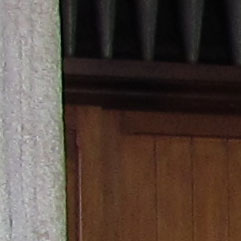 | |||
80 ISO Not available |
80 ISO |
80 ISO | ||
 |  |  | ||
100 ISO |
100 ISO |
100 ISO | ||
 |  |  | ||
200 ISO |
200 ISO |
200 ISO | ||
 |  |  | ||
400 ISO |
400 ISO |
400 ISO | ||
 |  | 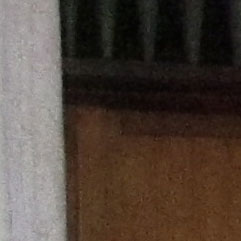 | ||
800 ISO |
800 ISO |
800 ISO | ||
 |  | 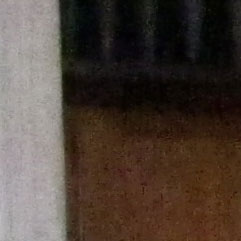 | ||
1600 ISO |
1600 ISO |
1600 ISO | ||
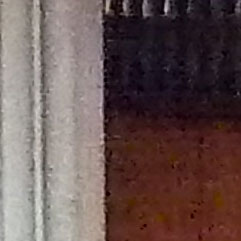 |  |  | ||
3200 ISO (High Sens scene mode) |
3200 ISO (High Sens scene mode) |
2500 ISO (Low Light scene mode) |



